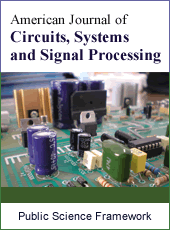American Journal of Circuits, Systems and Signal Processing
Articles Information
American Journal of Circuits, Systems and Signal Processing, Vol.6, No.1, Mar. 2021, Pub. Date: Jun. 2, 2021
Methods for Detecting and Taking Human Sphygmosignals
Pages: 1-5 Views: 1809 Downloads: 315
[01]
Xakimjon Nasritdinovich Zaynidinov, Information Technology Department, The Tashkent University of Information Technologies, Tashkent, Uzbekistan.
[02]
Azambek Abdullaevich Turakulov, The Namangan Institute of Engineering and Technology, Namangan, Uzbekistan.
[03]
Fotima Tuychibaevna Mullajonova, The Namangan Institute of Engineering and Technology, Namangan, Uzbekistan.
Currently, there are a lot of methods for measuring the signals of human heart activity. Among of them, the electrocardiogram is the most informative. But, the making a cardiogram requires special equipment, which have relatively large dimensions and special conditions. In addition, cardiograms are usually made after a person has some clear signs of heart disease. Monitoring of heart activity using a sphygmogram is less informative than a cardiogram, but it has some advantages, such as ease and accessibility of measurement for each person who does not have special medical knowledge and training, the ability to develop portable measuring devices of small size like a wristwatch, daily monitoring without special conditions. In this article it is described some known methods and devices for detecting and taking biosignals (sphygmosignals) at the radial artery which result from heartbeat: the fingers aided method, the first mechanical sphygmograph, inductive coil method, using a device with capacitive sensor, with piezoelectric sensor, an optical heart rate sensor, an infrared ray sensor. Also, some new methods and devices of detecting and taking the radial artery pulse signals using a strain gauge, Hall magnetic sensor, laser distance measurer are suggested. As a result of using the above methods it may be taken sphygmosignals as a finite numerical sequence of discrete analog signals suitable for processing. And received signals can also serve to monitor the activity of the heart.
Cardiosignals, Sphygmography, Radial Artery Sensor, Discrete Biosignal, Heart Rate Sensor
[01]
https://repost.uz/statistika-raznitsya
[02]
Luisa María Arvide Cambra. THE EDITIONS AND THE TRANSLATIONS OF AVICENNA'S CANON OF MEDICINE. Journal of Advances in Humanities. 2016, Volume 4, Number 1.
[03]
O. V. Sorokin, R. Manokhar, A. S. Panova, M. A. Subotyalov. STAGES OF FORMATION AND DEVELOPMENT OF SCIENTIFIC IDEAS ABOUT PULSE DIAGNOSTICS. Bulletin of the Novosibirsk State Pedagogical University. 2017, Volume 7, No. 1. DOI: 10.15293/2226-3365. 1701. 11
[04]
R. E. Dudgeon. The Sphymography: its history and use as an aid to diagnosis in ordinary practice. London, 1882.
[05]
Winncy Y. Du, Resistive, Capacitive, Inductive, and Magnetic Sensor Technologies, CRC Press, 2014 ISBN 1439812446, Chapter 4 Inductive Sensors
[06]
Larry K. Baxter (1996). Capacitive Sensors. John Wiley and Sons. p. 138. ISBN 978-0-7803-5351-0.
[07]
Gautschi, G. (2002). Piezoelectric sensorics. Springer Berlin, Heidelberg, New York. p. 3.
[08]
Piotr Tutak. APPLICATION OF STRAIN GAUGES IN MEASUREMENTS OF STRAIN DISTRIBUTION IN COMPLEX OBJECTS. JACSM 2014, Vol. 6, No. 2, pp. 135-145.
[09]
H. Heidari and V. Nabaei, “Magnetic sensors based on Hall effect,” in Magnetic Sensors for Biomedical Applications (John Wiley & Sons, Inc., 2020), pp. 33–56.
[10]
Shirzadfar H, Ghaziasgar MS, Piri Z, et al. Heart beat rate monitoring using optical sensors. Int J Biosen Bioelectron. 2018;4(2):48–54. DOI: 10.15406/ijbsbe.2018.04.00097
[11]
Kaveh Bakhtiyari, Nils Beckman, Jürgen Zieglera. Contactless heart rate variability measurement by IR and 3D depth sensors with respiratory sinus arrhythmia. Procedia Computer Science. Volume 109, 2017, Pages 498-505
[12]
G. Berkovic & E. Shafir, “Optical methods for distance and displacement measurements,” Advances in Optics and Photonics 4, pp. 441 -471, 11 Sep -2012.

ISSN Print: 2381-7194
ISSN Online: 2381-7208
Current Issue:
Vol. 6, Issue 1, March Submit a Manuscript Join Editorial Board Join Reviewer Team
ISSN Online: 2381-7208
Current Issue:
Vol. 6, Issue 1, March Submit a Manuscript Join Editorial Board Join Reviewer Team
| About This Journal |
| All Issues |
| Open Access |
| Indexing |
| Payment Information |
| Author Guidelines |
| Review Process |
| Publication Ethics |
| Editorial Board |
| Peer Reviewers |


